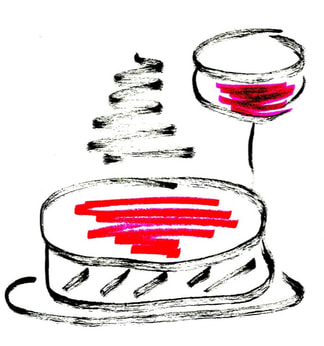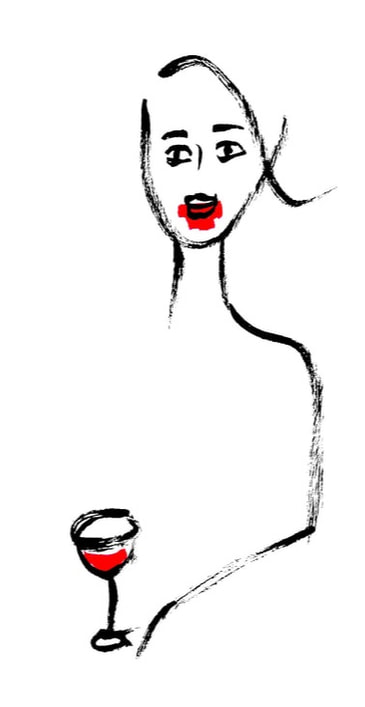 You are the captain of your drinking ship. You are the captain of your drinking ship. Would you say weather plays an important role in setting the tone for your choice of an earthy or fruity wine? For instance, here in San Francisco, we are experiencing twenty-five-mile-an-hour winds and, for some, subsequent power outages. I can tell you that my run at forty-three degrees Fahrenheit this morning in Golden Gate Park was nothing short of invigorating. Peter called out “good luck” as I leapt forth into the wild outside. I had a psychological advantage, though: friends had sent photos of themselves enjoying time with their families in several feet of snow. That’s why today’s run was totally in my wheelhouse. Tonight the wine will be a nice earthy red, maybe a Nero d’Avola, to keep a late winter’s brisk weather at bay. A quick look into the wine fridge reveals the perfect candidate: a 2017 Cerasuolo di Vittoria by Donnafugata, a spicy blend of Nero d’Avola and Frapatto out of Sicily. As we are having this conversation, I have been deciding whether to cook tonight’s Halloumi cheese over vegetables in the pizza oven outside as planned or pay my due respects to the gusty winds and cook a traditional red-sauce pasta indoors. While I am leaning toward the pasta dinner as a matter of practicality (pizza ovens are not keen on inhaling blustery winds), if we lose electricity like some of our San Francisco sisters and brothers, the decision will be made for me. Cooking outside with fire is my favorite, wind be damned. Either scenario bodes well for the Cerasuolo and the dinner. On a different day, one where I have been in the backyard laying in the warm sun reading a good detective story, I might pick a different Italian offering: a fruity Schiava, perhaps. The light-bodied 2019 by Manincor from Italy’s Alto Adige, also in the wine fridge, would be a perfect pairing for a warm easygoing day. Choosing an earthy or fruity wine can also depend on the course of your dinner and what you are serving. With a Caesar salad, will you opt for the floral, white peach and lemon zest aromas of a Torrentés from Argentina to marry with the zing of the salad’s Dijon mustard and anchovy? Or do you favor the more earthy, grassy experience offered by a Sauvignon Blanc from the Nelson region of New Zealand to complement the crunchy freshness of romaine lettuce?  Consider an earthy Merlot from the Walla Walla Valley wine region to pair with a tomato soup. Consider an earthy Merlot from the Walla Walla Valley wine region to pair with a tomato soup. For a steaming bowl of tomato soup, do you go with an earthy Merlot from the Walla Walla Valley wine region to make the most of the tomatoes’ savory dirt elements? If the tomato soup is, in fact, a chilled gazpacho, would you instead reach for a fruity Godello to play nicely with the acidic elements of the soup? When grilling lamb chops for your main course, you could reach for the dark plum and fig fruit flavors of a Bobal from the Utiel-Requena wine region of Valencia in Spain to offset the lamb’s gamey, ashy flavors. For a more earthy, brooding wine to accompany the grilled lamb, drink a Sagrantino di Montefalco for the black fruit, licorice and pine tar that it brings to the table. For a cheese course, do you want a fruity and versatile Chenin Blanc or a more savory yet equally versatile Roussanne? As the captain of your drinking ship, you can have fun alternating between fruity and earthy wines, even within the same course, and explore the differences. Earthy wines have aromas and flavors evocative of the earth and often have savory characteristics. You might get mushrooms, vegetation, soil, wet leaves, rocks, game, minerals, leather, or tobacco from these wines. Time in oak, wine aged sur lie (kept in contact with spent yeast cells), bottle aging, oxidation, fermentation practices and environments, and other factors affect the perceived earthiness of a wine. The vineyard’s terroir has a tremendous impact on a wine’s earthiness. For instance, red wines produced from iron-rich clay soils sometimes deliver a mild yet surprisingly pleasant bloody note. If you pick up smokey or ashy elements from a wine, you might be right to suspect that the grapes were grown in volcanic soils. The use of wild yeast, commercial yeast, or a combination of both during fermentation also inform a wine’s earthy qualities. Biodynamic, organic and natural winemakers promote a minimalist approach to winemaking, and many opt to use the wild yeast that naturally occurs in the vineyard and cellar environments rather than rely on a commercial laboratory to supply yeast that has been propagated to produce a reliable outcome. Natural winemakers, as well as traditional winemakers who use natural yeast, claim that their use of indigenous (wild) yeast promotes a more complex flavor profile. These winemakers know they are taking a chance that the environment will also provide unwanted spoilage bacteria, so sanitation becomes even more important than usual. Winemakers who rely entirely on natural yeast can choose to mitigate their risk by adding a small amount of sulfites to kill harmful bacteria and to stabilize the wine. If you are a winemaker who elects to use commercial yeast, you are in the composer’s seat, choosing from a library of offerings with qualities that go well beyond earthy or fruity. Several of my friends allow the natural yeast to do their work for a day or two, then add commercial yeast to clean up any possible undesirable bad actors that could ruin the beverage. Yeast is highly complex and fascinating and scientists admit they do not fully understand everything that is happening during the fermentation process. As a homebrewer, I enjoy playing with various approaches, whether it is going completely natural, mixing a combination of commercial yeasts, or starting wild then tempering the fermentation with commercial yeast. If I had shareholders to please, my choices would be much more restricted. Additional factors affect a wine’s earthiness. Grapes grown in cooler climates such as Burgundy, France and Italy’s Trentino-Alto Adige do not achieve the sugar levels enjoyed in warm climates with intense sunshine such as California’s Sacramento Valley and Argentina’s Mendoza Province. Cool-region wines tend to be less fruity, revealing more earthy notes in their flavor profiles. A grape’s ripeness level has a tremendous influence on earthy vs. fruity aromas and flavors. Fully ripe grapes are prone to display fruity characteristics while under-ripe grapes are inclined to offer herbal or vegetal attributes.  Red wines produced from iron-rich clay soils can deliver a mild yet surprisingly pleasant bloody note. Red wines produced from iron-rich clay soils can deliver a mild yet surprisingly pleasant bloody note. A quality wine can be fruity or savory, and many wines share elements of both. For instance, a Grüner Veltliner from the Wachau region of Austria has citrus and/or stone fruit characteristics that are typically accompanied by the earthy and savory notes of white pepper (and perhaps toast, in those that are aged). Sometimes a wine is aged beyond its prime and displays little to no fruit characteristics. This is considered a flaw because what remains is a mere flavor shadow compared to the wine at its peak. Fruity wines showcase fruit aromas and flavors over and above other aspects. A lot of people associate a fruit-forward wine with sweetness, but many fruity wines actually finish dry. The next time you perceive what you think is sweetness, ask yourself if you are in fact detecting fruit flavors rather than sugar. To distinguish one from the other, pay close attention to the finish of the wine. A wine that finishes dry, even if you experience delightfully bright red fruit such as raspberries and cherries, is considered to be a dry wine. Some winemakers go to great lengths to preserve the fresh fruit purity of their wine by fermenting and aging the wine in stainless steel, concrete or other air-tight vessels instead of oak. This is because oak allows in small amounts of oxygen to change the nature of the finished wine to include non-fruity elements. A lot of people associate a fruit-forward wine with sweetness, but many fruity wines actually finish dry. The next time you perceive what you think is sweetness, ask yourself if you are in fact detecting fruit flavors rather than sugar. To distinguish one from the other, pay close attention to the finish of the wine. Fruitiness is often associated with New World wines (North and South America, Australia and New Zealand, South Africa, etc.). Earthiness is more associated with Old World wines (France, Italy, Germany, Spain, Portugal, etc.). There are many exceptions to this line of thinking, especially as winemakers travel the world to experience wine in other countries and share ideas and technical information. The drinking public also helps shape how wines are made. Styles go in and out of popularity and many winemakers accommodate what is fashionable or risk losing sales. For instance, the majority of buyers today ask for a dry rosé, so producers all around the world create offerings typical of the crisp, pale-colored, light-bodied, dry style of the Côtes de Provence rosés of Southern France. In the past, sweet rosés were all the rage. Drinkers who are new to wine often prefer fruity styles. As their palates mature, these drinkers begin to appreciate the complexity and intrigue of savory elements in the beverage. Oh, for heaven’s sake, rain is suddenly coming down hard. What, is that hail pounding on my skylight? I guess the pasta dinner will be made tonight. Can’t say I’m sorry about that, because now I can rummage through my farmers market finds to create a meal for Peter that will be just right for that Cerasuolo. Soon I will put away the “pen” and enjoy the warmth of a hot stove. I will create a meal that will be the perfect finish to a day that engaged my body with a good run, my mind with this conversation, and my senses with excellent wine. Here’s a toast to being flexible without giving up on what matters in life: good food, good wine, good health and, especially, good company. Earthy Varieties Whites: Sauvignon Blanc Chardonnay (Chablis) Garganega (Soave and Gambellara) Grüner Veltliner Roussanne Savagnin Silvaner/Sylvaner Vermentino Reds: Aglianico Cabernet Franc Cabernet Sauvignon Carménère Corvina Fumin Grenache Malbec Mencía Merlot Mondeuse Noire Mourvèdre/Mataro/Monastrell Nebbiolo Nero d’Avola Piedirosso Pinotage Pinot Noir Poulsard/Ploussard Sagrantino Sangiovese (Chianti Classico) Syrah/Shiraz Tempranillo Trousseau/Bastardo Fruity Varieties Whites: Albariño Chardonnay Chenin Blanc Friulano Gewürztraminer Godello Malvasia Bianca Marsanne Moscato Riesling Torrontés Viognier Reds: Bobal Cornalin Frappato Gamay Garnacha/Grenache Nerello Mascalese Pinot Noir Plavina Schiava St. Laurent Teroldego Valdiguié Zweigelt This is one in a series of Grape Detective blogs featuring the attributes of wine and how your love for a specific wine grape may lead you to discover new grapes with similar characteristics. The focus of the list is grape variety and does not include blends, wine regions, or styles.
0 Comments
Leave a Reply. |
AuthorLyne Noella Archives
October 2022
Categories
All
|


 RSS Feed
RSS Feed
